|
Walsall, like the other Black Country
towns grew rapidly in the 19th century, as the region
evolved into a vast industrial area that relied heavily on
the thousands of people that came here looking for work. In
the first half of the century the population more than
doubled, then doubled again by 1875.
Houses were in short supply, so the
poorer members of society lived in overcrowded conditions,
often with several families sharing a small house. The
essential requirements for healthy town life were not in
place, and had not previously been considered. The water
supply was inadequate, and more often than not impure. Open
sewers were commonplace, toilets were rudimentary, and
washing facilities were not available. Proper drainage did
not exist and so dirty water would run into stagnant pools.
Many people were unhealthy and died at a comparatively early
age.
Having said all that, the general
health of the town was considered to be good when compared
with other areas, but lung disease was common, as were
measles, typhoid, and scarlet fever. There were outbreaks of
cholera in 1832 and 1849, and smallpox in 1868, 1869, and
again in 1871 and 1872. There were also many industrial
accidents in the factories and mines, which could be very
serious, needing rapid attention and a lot of care.
In the late 1850s people from Walsall
were sent as patients to Birmingham Hospital. In 1859 the
hospital’s secretary sent a letter to the town asking the
people of Walsall to send more money. It points out the
discrepancy between the amount of money sent and the cost of
treating patients. When
Samuel Welsh, a Scottish journalist and editor of the local
newspaper, the Walsall Free Press and South Staffordshire
Advertiser saw the letter, he realised the importance of
establishing a hospital in the town, and advocated the establishment of a cottage
hospital along the lines of the one at Middlesbrough, the
first of its kind. It had been established in 1861, in two
small cottages where nursing was carried out by members of
the Sisters of the Good Samaritan Order, from Coatham, near
Middlesbrough. Samuel had previously worked in Middlesbrough
and greatly admired the work of the sisters.
At the time, many people acknowledged
the urgent need for a hospital in Walsall and so Samuel
Welsh started a hospital campaign. In 1862 and 1863 Samuel
Cox was Mayor of Walsall. On 14th June, 1863 he called a
meeting to discuss the possibility of opening a cottage
hospital in the town. A committee was appointed to look into
the matter, which was ably assisted by the Rev. J.
Postlethwaite of Middlesbrough.
Premises were soon acquired in Bridge
Street, and the Cottage Hospital opened on Thursday 8th
October, 1863. Initially there were eight beds, but the
number was soon increased to twelve. The Walsall Free Press
and South Staffordshire Advertiser reported the opening as
follows:
|
The
Walsall Free Press and South Staffordshire
Advertiser. 8th October, 1863.
The buildings, which
are situated, as most of our townspeople are
aware, in Bridge Street, are central, and
admirably adapted for the purpose; the
external appearance being neat without being
imposing, while the internal construction is
such as to render them exceedingly suitable
for an hospital, there being ample
accommodation for twenty beds. The rooms are
lofty and well ventilated, and the houses
which until their privacy was destroyed by
the erection of a factory on the opposite
side of the street, had been the dwellings
of parties moving in the better circles of
society, are in excellent repair. One of the
houses is devoted exclusively to hospital
purposes and the other, which may be
considered the domestic portion, is set
apart as the residence of the sisters and
domestics. On the basement floor are the
kitchens, cellars, etc.
On the ground floor are
the outpatients' room, surgery, private
reception room, and convalescent females'
dining room. On the second floor, on the
hospital side of the building, are the male
wards, in one of which are two beds, in the
other three, the linen closet, etc. On the
upper storey are the female wards. The other
portion of the house contains the private
sitting room and dormitories of the sisters
and domestics. It is worthy of notice that
the iron bedsteads, some of the beds and
mattresses and a large quantity of the bed
linen, and other articles of furniture, as
also all the gas fittings, are gifts from
the different tradesmen of the town. The
arrangement of the wards is really neat and
cheerful.
At present there are
five beds for male and three for female
patients; but the hospital, as we have
stated, being capable of accommodating 20
inpatients, the number of beds will be
increased as funds accumulate, and
applications for admission increase. The
necessary preliminaries for opening having
been completed, the institution was thrown
open for public inspection on Monday and
Tuesday. On the former of these days it is
estimated that upwards of 4,000 persons
passed through the different wards, and on
Tuesday, notwithstanding the unfavourable
state of the weather, fully that number of
visitors were admitted, and hundreds went
away each day unable to gain admittance.
Among the visitors on Tuesday were Lord and
Lady Hatherton.
While his lordship was
inspecting the wards a poor man named James
Houston was brought in, who had his leg
fractured at one of Mr. Bagnall's pits, at
the Birchills. Owing to the arrangements
made for opening the hospital this day for
public inspection, it was impossible to
admit the poor fellow, who was removed to
his lodgings, where he was attended by Dr.
Wyllie, the medical officer to the hospital,
and one of the sisters, and today he will be
removed to the hospital. It is calculated
that during the three days it was open it
was inspected by 10,000 visitors. It is
worthy of remark that the conduct of the
visitors - many of whom shed tears of
gratitude and thankfulness for the
establishment of such an institution in the
town - was most exemplary, and affords
another proof that even the humblest classes
are susceptible to impressions of kindness
and generosity. |
|
Nursing care was provided by members of
the Sisters of the Good Samaritan Order, the first being
Sister Mary Jacques, known simply as Sister Mary. She
initially supervised the setting-up of the hospital and the
purchase of equipment, then nursed there for fifteen months,
until she fell ill with scarlet fever and returned to Coatham to convalesce.
Her replacement, Sister Dorothy Wyndlow
Pattison, known as Sister Dora, arrived at the hospital on 8th
January, 1865 and stayed for two months, but returned to
Walsall in November. Thanks to her outstanding devotion to
duty she will never be forgotten.
| |
|
| Read about Sister
Dora |
 |
| |
|
Although the number of beds in the Cottage Hospital had
been increased to twelve, the building was too small to cope
with the demand, and so the Hospital Committee looked around
for larger premises. They acquired a 1¾
acre site off Bradford Street called 'The Mount' for
£2,000, and spent a further £1,500 enlarging and adapting
the existing former private school into a hospital with
four wards, thirty beds, and an outpatients department. The
new Cottage Hospital opened on 12th April, 1868.
In July 1872 the Epidemic Hospital opened in Hospital
Street off Green Lane. It was built at a cost of £2,000 but
soon gained a terrible reputation. Sufferers preferred to
take their chances at home rather than enter the hospital.
By the end of 1875 the Cottage Hospital had become
infected with erysipelas, which meant that patient's wounds
would be infected. Contemporary medicine offered no
solution, the only option was to close the hospital. The
hospital committee had been considering the possibility of
building a new hospital for several years and collecting
money for the purpose. While the new hospital was under
construction a temporary hospital was established
in a house in Bridgeman Place, owned by the London & North
Western Railway. Bridgeman Place was off Bridgeman Street, opposite Station
Street. The foundation stone for the new hospital
was laid on 2nd April, 1877.
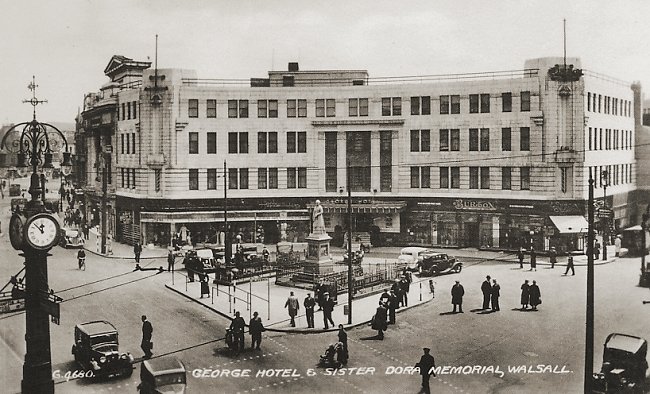
Sister Dora's statue on The Bridge.
From an old postcard.
The temporary hospital stood close to the railway and so
patients were continually disturbed by passing trains. The
hospital only had ten beds on four floors and so there was
little space, and not even enough room to manoeuvre a
stretcher between floors. Patients (alive or dead) had to be
carried, usually by Sister Dora. Because of the lack of
space many people had to be treated as outpatients. In 1877
over 15,000 people were treated in this way, usually by
Sister Dora herself. The house was far from suitable
for use as a hospital. In 1878 it became infected with
typhoid fever and had to be closed.
The New Cottage Hospital
The new Cottage Hospital was officially
opened 4th November, 1878 by the Mayor William Bayliss. The
hospital cost over £5,000 to build and had 7 wards
with 42 beds. In the first year there were 407 inpatients,
around half of whom were suffering from industrial injuries.
The hospital quickly gained a high reputation both at home
and abroad. Visitors came from many countries to see the
hospital and view its facilities. In 1894 it became the
Walsall & District Hospital
On Sunday the 24th March 1895, a severe
gale battered the town, completely destroying Barnett Ward
and damaging another so badly that it had to be demolished.
Although the buildings were occupied at the time, no one was
hurt. The hospital had been suffering from a shortage of
beds, and so two new larger wards were built, that were officially opened on 16th July, 1896 by the Earl of
Dartmouth.
|

Barnett Ward after the
storm. |
At the opening ceremony the nephew of
the late Henry Boys presented a cheque for £3,000 to the
hospital. £2,000 was a donation to one of the wards, which
became known as Henry Boys Ward, the other £1,000 paid for
surgical appliances.
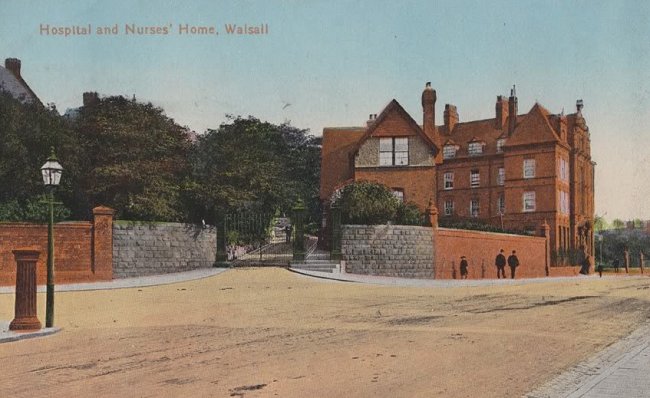
The hospital entrance and the Nurses'
Home. From an old postcard.

From the 1899 Walsall Red Book.

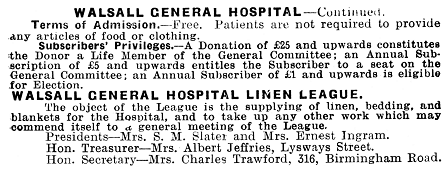
From the 1934 Walsall Red Book.

From the 1934 Walsall Red Book.
By the end of the century the number of
resident nurses had increased from six to fourteen. The
hospital could only accommodate six of them and so plans
were made for an enlarged nursing home, which would be paid
for by a fund set up in 1900 by the Mayor W. J. Pearman-Smith.
The fund managed to raise £4,412. It was augmented by a
three day bazaar in the Town Hall, opened on each day by a
different celebrity. They were the Duchess of Sutherland,
the Countess of Warwick, and Lady Forster. The bazaar raised
£2,283.
The new Nurses Home had been built at a cost of
£6,536, and opened on 30th October, 1902.

From an old postcard.
In the following year an outpatient
department opened, and the operating theatre was
refurbished, and now included a sceptic theatre. In the
early years of the twentieth century, x-ray machines were in
their infancy, and mainly confined to teaching hospitals. In
1904 the hospital became one of the first general hospitals
to acquire its own x-ray machine. By this time the hospital
was annually treating around 800 inpatients, 4,000
outpatients, and 2,500 casualties.
The hospital continued to grow over the
next few years with a new dispensary, an enlarged x-ray
room, and the building of Thorpe and Farrington wards, each
with twelve beds.

A group of nurses from 1906.
During the First World War military
service caused a severe shortage of medical staff, which
resulted in the temporary closure of the eye, ear, nose and
throat services. The military authorities asked the hospital
to give priority to men with minor ailments that prevented
them from doing military service. The staff also trained
members of the British Red Cross Society in nursing, in case
they were needed for the war effort.
The Thorpe and Farrington wards soon
filled with injured soldiers from the front, mainly members
of the South Staffordshire Regiment. In 1915 there over
1,000 inpatients for the first time.
The cost of treating patients had risen
by fifty percent by 1918 which resulted in the hospital
falling into serious debt. The Mayor S. M. Slater appealed
for funds to help the hospital and raised £10,767 which
easily cleared the debt. Also in 1918 the hospital became
Walsall General Hospital. Patient numbers continued to rise.
In 1923 there were 1746 inpatients, and 54,000 outpatients.
A new Casualty Department opened in 1929.
| |
|
| View photographs of
the General Hospital |
 |
| |
|
Expansion continued with the opening of
the Mason Ward in 1925, funded by £10,000 left to the
hospital in the will of the late Dr. William Mason, honorary
physician to the hospital. The hospital continued to
struggle financially and so in 1937 a pay-bed wing was
built. Further additions included a new operating theatre,
and an orthopaedic and x-ray department, which opened in
1939.
In July 1948 the National Health
Service took control of medical care in the country, and all
of Walsall’s hospitals were run by the Walsall Hospital
Management Committee which held its first meeting on 21st
June, 1948.
Many locals felt that Sister Dora
should be honoured by changing the hospital’s name to the
Sister Dora Hospital. The hospital management felt the
existing name was more appropriate, however in 1954 a
compromise was reached, and the hospital became the Walsall
General (Sister Dora) Hospital.
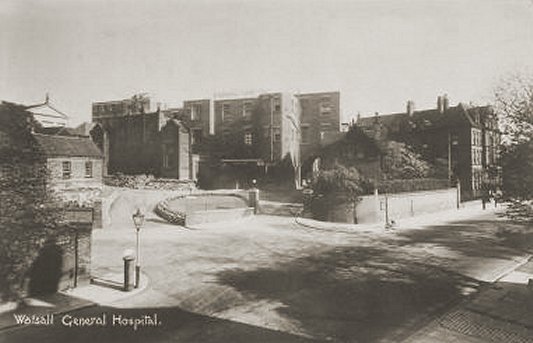 |
| In the 1960s alterations and
improvements were made to the casualty and physiotherapy
departments, and in October 1973 the hospital came under the
control of Walsall Area Health Authority.
The government had
decided to introduce fourteen regional health authorities,
including the one at Walsall, which also controlled Aldridge
and Brownhills. |
|
In the 1980s money was again in short
supply and so the Area Health Authority decided to
centralise health care at the Manor Hospital. As a result,
the General Hospital closed on 4th December, 1989. It had
been hoped to save the buildings for use as a hospital for
the care of mental health patients, but the site was thought to
be unsuitable. The buildings were demolished in 1995.
|
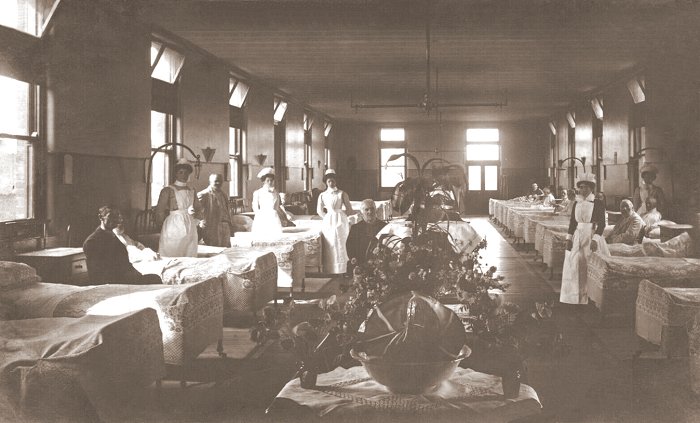
A men's ward in the early
20th century. |
|
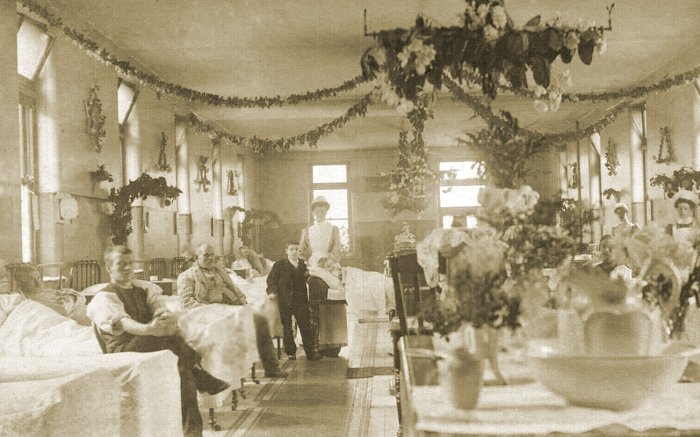
Another men's ward in
the early 20th century. |
The Manor Hospital
The Manor Hospital was built around the
old Central Union Workhouse that was built in Pleck Road in
1838, and the workhouse infirmary, which opened in
1896. In 1899 Dr.
George M. Fox became Medical Officer to the workhouse, and
in 1902 a second identical infirmary with four wards was
built alongside the existing building. The eight wards had a
total of 200 beds and catered for patients who were admitted
under the conditions of the Poor Law. There were wards for
men, wards for women, wards for children, and an operating
theatre.
| |
|
View photographs of
the
Manor Hospital |
 |
| |
|
By 1926 there were thirty three nurses
working in the infirmary, which had a nurses’ home that had
been built to house twelve. At the time sixteen nurses were
living in overcrowded conditions in the home, and seventeen
were living in small cottages on the site. To overcome the
problem a new nurses’ home with 50 single bedrooms was built
behind the infirmary, along with a house for the full-time resident Medical Officer. It later became the Manor
Hospital’s Occupational Health Department.
Poor Law Infirmaries were run by a
Board of Guardians until the late 1920s. In 1927 the
government decided that they would come under the control of
local authorities. One of the last acts of the Board of
Guardians before Walsall Council took charge was to rename
the infirmary and the workhouse. At the end of 1928 the
infirmary became The Manor Hospital, and the workhouse
became Beacon Lodge.
The Manor Hospital was the largest
hospital in the town with 300 beds compared with 100 at the
General Hospital, 43 at Pelsall Hall Sanatorium, 34 at
Goscote, 12 at Sneyd Lane, and 11 at Bloxwich Hall. The
hospital was now an ordinary municipal establishment,
paid-for by the ratepayers, and only accepting patients who
lived in the borough. Expansion continued in the 1930s with
the conversion of the old nurses’ home into the hospital
entrance with receiving wards, improved x-ray facilities,
and a new maternity unit.
During the Second World War the
patients were moved into Beacon Lodge so that the hospital
could cater solely for wartime casualties. After the
formation of the National Health Service in 1948, Walsall
Hospital Management Committee changed the name of Beacon
Lodge to St. John's Hospital which was subsequently
developed as the hospital’s geriatric unit.
In the 1950s some of the old wards were
modernised, and facilities for the patients were improved.
Refurbishments continued in the 1960s with the conversion of
the old recreational hall into the Joseph Leckie Ward,
improvements to the Casualty and Physiotherapy departments,
the building of a new operating theatre and x-ray
department, and a new laundry and boiler house. The new
Geriatric Block opened in 1973, and the new west wing was
opened by Princess Diana on 26th June, 1991. Another
significant event took place in April of that year when The
Manor Hospital and Goscote Hospital became Walsall Hospitals
NHS Trust which employed over 2,000 full time staff.
The hospital continues to expand and
improve patient facilities. On Monday 13th September, 2010
the last section of a £170,000,000 building project opened
to patients for the first time.
Goscote Hospital
Before the First World War the local
Health Committee began looking at the possibility of opening
an isolation hospital for infectious diseases such as
diphtheria, scarlet fever, and typhoid. The opening of a
suitable hospital was delayed by the war, and the terrible
recession that followed. The world order had changed,
Britain's foreign markets collapsed, mills, mines, works and
shipyards were shut by the day, and unemployment rose to
11.3 percent. The country did not know which way to turn and
began to move away from heavy industry, towards financial
services. They were very difficult times, just like today.
Money was in short supply and so in 1921 the government
urged local authorities to make cuts and save money.
In 1920 Walsall Council had purchased
Goscote Hall Farm and the surrounding land, which was ideal
for an isolation hospital. The project was held-up until
1928 when building finally work began. The new hospital was built by
William Kendrick & Sons at a cost of £17,995, and was
officially opened on 1st April, 1930 by the Mayor of
Walsall, E. H. Ingram. It consisted of two
wards, each having eight beds, plus fourteen beds with side wards,
a cubicled block with ten beds, and an administration
building.
In 1933 a tuberculosis building opened
with 22 beds, and two years later a new ward with 26 beds
was added.

The new extensions at Goscote
Isolation Hospital that officially opened on 24th April,
1936.

Goscote Isolation Hospital.
In 1949 it became Goscote Hospital, and
plans were made build a general hospital on the site for the
whole of Walsall. In 1964 the scheme came to an end when
Harold Wilson’s government prohibited the sale of land for
NHS purposes. Instead Goscote became an annex to the Manor
Hospital.
Although there were 160 beds in the
Manor Hospital dedicated to geriatric care, more were
needed, and so two new geriatric wards were built at Goscote,
called ‘Conway’ and ‘Warwick’ wards. They opened in 1975 and
were situated on either side of a link corridor, each with
twenty eight beds.
In 1976 the tuberculosis building was
badly damaged in a storm, and had to be closed because it
was too expensive to repair. Plans were made to extend the
hospital and so in the 1980s great changes took place. In
January 1984 Balmoral, Harlech, and Ludlow wards opened,
together with an x-ray department. A new kitchen and staff
dining room opened in 1987, and the rebuilt ‘Edinburgh’ ward
for geriatric patients, and a new chapel, opened in 1988.
The hospital had six wards: Balmoral,
Conway, Edinburgh, Harlech, Ludlow, and Windsor. It closed
on 30th April 2006, and was transferred to the Manor
Hospital.
Today the site is owned by Walsall
Teaching Primary Care Trust and was redeveloped in 2011 to
include a Dementia Care Unit, a Palliative Care Centre, and
NHS offices.
Sneyd Lane Epidemic
Hospital
The hospital opened in 1901 at Bloxwich
as a replacement for the old Epidemic Hospital in Hospital
Street. It was quite isolated, and stood in an area of
woodland on a 40 acre site to the north of Sneyd Lane. There
was a permanent building with 12 beds, and a number of
‘temporary’ corrugated steel wards, a little like Nissen
huts.
The hospital only opened when necessary
to care for illnesses such as smallpox and scarlet fever. It
closed after the opening of Goscote Hospital in 1930.
Pelsall Hall Sanatorium
Before the First World War plans were
made to open a sanatorium in Walsall for sufferers of
tuberculosis. In 1917 Pelsall Hall, in Paradise Lane,
Pelsall was purchased from the Charles family and converted
into a sanatorium. It had thirty seven beds, seventeen for
men, fourteen for women, and six for children. The
sanatorium officially opened on 23rd October, 1918. Facilities were improved in 1924 when the old hall was
converted into a dining and recreational area with a snooker
table and a wireless. By the mid 1930s patients were being
cared for at Goscote, and so patient numbers at Pelsall
started to fall. The sanatorium closed in 1950 and the hall
became Walsall Nurse Training School. It is now a home for
the elderly.
Bloxwich Maternity and
Child Welfare Hospital
In 1927 Walsall Council purchased a
large Victorian house in High Street, Bloxwich called ‘The
Manor House’. It had previously been owned by several
generations of the Foster family. The house was purchased
for the land at the front which was needed for a road
widening scheme. On 20th July, 1929 the house officially
opened as the Maternity and Child Welfare Hospital. It had
two wards, each with four beds, one ward with two beds, an
isolation ward, an operating theatre, a receiving ward, a
nursery, and accommodation for the staff.
It now is a hospital for elderly people
with mental health problems.
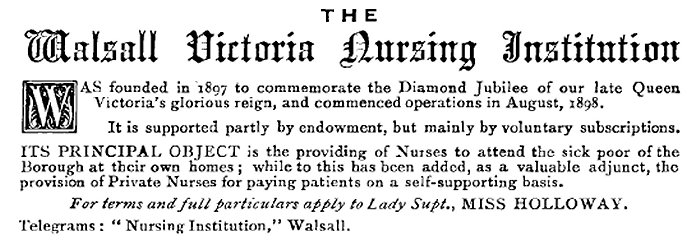
An advert from 1902. |